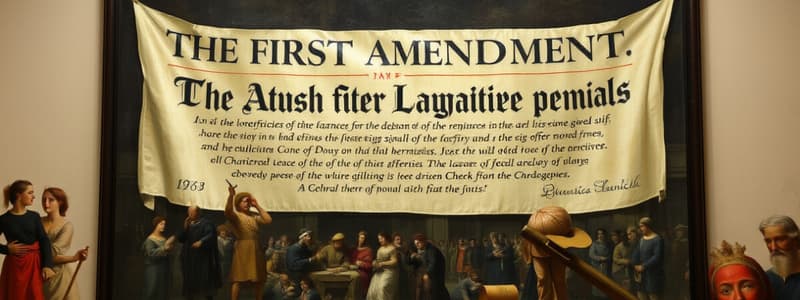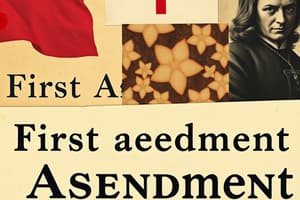Podcast
Questions and Answers
What was the basis of Thomas Van Orden's lawsuit against Texas?
What was the basis of Thomas Van Orden's lawsuit against Texas?
The lawsuit argued that the Ten Commandments monument on the grounds of the state capitol represented an unconstitutional government endorsement of religion.
What was the ruling of the district court and the Fifth Circuit Court of Appeals regarding the Ten Commandments monument?
What was the ruling of the district court and the Fifth Circuit Court of Appeals regarding the Ten Commandments monument?
They ruled against Van Orden, stating that the monument served a valid secular purpose.
According to Van Orden, what are the main arguments against the Ten Commandments monument?
According to Van Orden, what are the main arguments against the Ten Commandments monument?
- It expresses a religious message. (correct)
- It is part of a historical tradition.
- It favors one religion over others. (correct)
- It serves a valid secular purpose.
The monument's placement emphasizes its religious significance according to the petitioner's argument.
The monument's placement emphasizes its religious significance according to the petitioner's argument.
What was the response from the respondent regarding the monument?
What was the response from the respondent regarding the monument?
What was the Supreme Court's decision in the case of Van Orden v. Perry?
What was the Supreme Court's decision in the case of Van Orden v. Perry?
What did the plurality opinion, delivered by Chief Justice William H. Rehnquist, state regarding religious content?
What did the plurality opinion, delivered by Chief Justice William H. Rehnquist, state regarding religious content?
Flashcards are hidden until you start studying
Study Notes
Case Overview: Van Orden v. Perry
- Thomas Van Orden filed a lawsuit against Texas regarding a Ten Commandments monument at the state capitol, claiming it violated the First Amendment's establishment clause.
- The establishment clause prohibits government endorsement of religion, specifically by preventing laws that favor one religion over another.
Petitioner Arguments: Van Orden
- The monument is viewed as a religious symbol, conveying a religious message.
- Its placement on state property suggests preferential treatment towards a specific religion.
- Van Orden argued that the monument lacks a secular purpose and effectively endorses religion.
Respondent Arguments: Perry
- The Texas monument is presented as not endorsing religion nor imposing coercion on observers.
- Its less prominent placement compared to other monuments on the capitol grounds is highlighted.
- The Ten Commandments are recognized as a historical legal code rather than purely a religious symbol.
- The monument's location puts it between the legislature and the supreme court, signifying its civic importance and influence on law and culture.
- Observers would not interpret the Ten Commandments as a representation of state policy.
Legal Question
- The central issue is whether the Ten Commandments monument violates the establishment clause of the First Amendment by representing an unconstitutional government endorsement of religion.
Conclusion of the Case
- The Supreme Court ruled in a 5-4 decision in favor of Perry, with Chief Justice William H. Rehnquist delivering the plurality opinion.
- The Court concluded that the establishment clause did not prohibit the monument, affirming its historical and cultural significance within the nation's tradition.
- Highlighted that having religious content does not inherently violate the establishment clause, with the monument being viewed in the broader historical context.
Studying That Suits You
Use AI to generate personalized quizzes and flashcards to suit your learning preferences.




